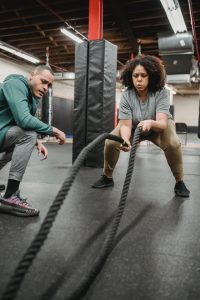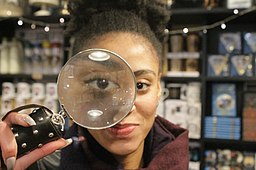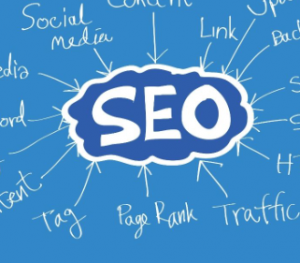Listen to the Podcast
SEO! Most of us have already heard about this word. Even if you haven’t heard about it, I am sure you have used Google search and found new businesses, which results from SEO.
Qurratulain Jawad, an SEO expert, is here today to explain what SEO or Search Engine Optimisation is and how it can help your small business grow.

About Qurratulain Jawad
Qurratulain Jawad is a marketer turned digital entrepreneur with 16+ years of experience and expertise in B2B Marketing, SEO, content strategy and growth hacking. She is also a startup evangelist who loves discovering, promoting and building innovative ideas and has worked closely with tech and non-tech startups in different regions and diverse markets.
Qurrat, please tell us about yourself and your career journey so far.
I started my career as a digital content writer. At that time, SEO was in a very basic form and not very technical, requiring little expertise and link-building. SEO fascinated me so much that I grew my career in digital marketing and stuck with SEO.

SEO continued to evolve so fast that what one had learned in an entire year was outdated in the next year. A single search engine algorithmic update meant that one had to learn again. At that time, there weren’t any YouTube videos on SEO, and only a handful of SEO experts existed. I kept growing with SEO and worked with different organisations at various levels, from SEO manager to director.
Qurratulain’s Success Story
I created my startup from scratch, called StartUpGuys.net, for under $100, which grew and started getting around 80,000 visits a month. I sold the website for six figures and took an exit. The website was very much based on SEO, and this is a real-life example of how SEO can take a website to great heights.
I took a very short break and then got back into the industry and now run getdigital.ae, which makes search engine-optimised websites and helps people who already have websites make the most out of SEO.
More Mompreneur Success Stories
Words of SEO Wisdom from Qurratulain Jawad
Qurrat, please tell us what is SEO?
In layperson’s terms, SEO is optimising your website for search engines, so whenever someone looks for services or products related to your business, your website should appear at the top of organic results. In short, SEO is useful to be found on any search engine.
SEO is not an independent solution. You can’t focus only on SEO and expect everything else to be fine. You must take care of the social media impact and have an integrated approach. The overall marketing strategy is also important, and I had to grow into the various dimensions along with it.
Inbound marketing and why business owners need an SEO strategy
Businesses should consider investing in SEO from the beginning because it is an organic growth method or inbound marketing. This means that you are not going outside to tell people to buy from you, but people come to you to buy from you, and it is organic.
Inbound marketing and organic growth are easily understood with an example. For example, if I am interested in healthy smoothies, I go on Google and search for healthy smoothies, and many search results come up. Typically, the top results are the paid results with a small ‘Ad’ displayed.
For those ads, the more you pay, the better the position you get. But when you finish your budget, your ads stop displaying, and people will not see them. But, if you have invested in marketing like SEO, you don’t have to spend on ads. Your website will appear organically at the top of searches simply because you have used the right SEO strategies. You do not have to suddenly stop using ads but can transition into maintenance mode. If you don’t have that much money to spend on very competitive ad keywords, there is no problem. You are organically at the top, so you will keep getting traffic.

Keyword Research
Keyword research is fundamental. It is the backbone of SEO, and some people might suggest that you use the Google Keyword tool and find a lot of keywords. These tools are very helpful, but you must also have the proper marketing strategy to find the right keywords. SEO is not as simple as it used to be. Now it is connected to your social media marketing and overall marketing, and it is all integrated. It would help if you first created buyer personas.
Here is a great resource for ‘Social Media Marketing Strategy’.
Buyer Personas to Select Keywords
You must know your different buyers and understand their user behaviour. The profile of your ideal customer is the buyer persona. Let us say that take an example of a company that sells the same service but with a slight difference to standalone customers and businesses. The buyer persona is different for the individual customer and the buyer company. So, keyword research is not simply going to the keyword tool and finding keywords with high volume. You must evaluate keywords based on your buyer persona and marketing strategy.

For example, take a business that sells gold necklaces. They used a keyword tool and found that the keyword word ‘gold necklace’ has the highest search volume. So, should they optimise their website for ‘gold necklace’? Probably not, because it is a very generic keyword. You have to focus on the intent of a keyword as well. Because somebody searching for a gold necklace might not be looking to buy it; he might be searching for design ideas. If that is the case, he is not your customer. So, who is your customer? The one who is looking to buy the gold necklace. So, how do you find that person?

You have to bring down the options there. That is exactly what we do when we create buyer personas. You differentiate the person looking for a gold necklace as a gift. So, if there is a keyword ‘gold necklace birthday gift’, the person searching for that will be your target customer. But, the search volume of that keyword maybe just a thousand. But, though it is significantly less, it is so targeted.
The Integrated Approach to Keyword Selection
As you can see, keyword research is a vast topic. The more you understand your business, the better you can do your keyword research. So, you must not rely only on tools to get a better keyword for your business. You have to look at your business model, customers and the whole strategy and then compare the outcomes of the tools with your strategy.
Do not just blindly trust what the tools are telling you. Link it with your own market research, what you know about your customers, and what they are likely to search.

Let us take another layman’s example of a client named John Doe. Let’s say he is a fitness coach in Dubai. John Doe’s marketing team told him that he ranked number 1 when somebody searched for John Doe. His marketing team tells him that everything is perfect and that he ranks at the top.
Only those who already know John Doe will search for the keyword ‘John Doe’. So, he is not driving any results. If you search for your name, your website will be at the top of the results. You need new people to find you. But, if John Doe optimises his website for ‘fitness coach in Dubai or ‘wellness coach in Dubai’, that makes a huge difference. When he optimises for transactional keywords, they are relatively difficult to rank.
SEO Optimised Content
There are two ways to use SEO keywords; the old-school way and the current way. The old-school way was used a decade ago. One would find a good set of keywords and develop all the content around the keywords, and boom! We have a lot of traffic. This trick doesn’t work much now because SEO is not only structured around keywords; it is about creating content around the things that matter. Maybe those things matter to a smaller or bigger segment of your customers but don’t have a good search volume. This may be because you have introduced a new product or service unavailable earlier.

Think Creatively
A lady came to me and told me that she had created small scented candles. We usually buy scented candles, use them and buy new ones when they are over. She was producing refills for scented candles, and this is something that people may not know is available.
How do we optimise such a product or business that is absolutely new? The keyword tool will tell you that there is no volume. People do not search for it because they believe such things do not exist.
Here you have to be very creative with the content. You can probably create content around what people search for and merge it with what you have. So, since people are searching for scented candles, you can create content around scented candles and then merge the content about refills with it. Ask the viewer, “Did you know you can buy a scented candle refill?”.
There are many new innovative ideas in the market that we never knew existed. In that case, with SEO, you must create a marketing strategy that creates awareness. You do not just sell.

What is the SEO Funnel?
Another way is to distribute your content into different sections based on the intent of the target customers. For example, informational content is the easiest to get rankings for. But, you may not make sales from the informational content. So, you have to create an SEO funnel where you create content around these informational topics and, from this content, divert the user to commercial content. From the commercial content, redirect the user to transactional content. When you try to do this, you get so many ideas. You streamline the customer journey through your content.

SEO Ranking
If I search for something such as house plants, the website ranking number one is the one I am most likely to click on. I might go beyond that, but typically, people do not go beyond the first page, and a very small percentage of viewers go to page two.
On-Page and Off-Page Optimisation
When it comes to ranking, there are more than 200 ranking factors that contribute to ranking a website. 80% of these factors exist on your website, and only 20% of factors are external.
So, out of 200 factors, you can control 80% of them. This is what they call on-page and off-page optimisation. The on-page optimisation is done right on your website, and the off-page is done outside. An example of off-page is building links for your website. We have customers who have built 5000 backlinks but are not getting traffic. This is because they have ignored the 80% of SEO that can be done on the website. So, in order to get good results, the very first thing to work on is your own website. You can get results by focussing only on this 80%. So, we can say that content is king!

Content is King
I have seen that the value of the quality of content has been proven over the last 16 years. In those days, the content that used to rank at number one is no longer relevant. Comparing it to the quality standards now, we can see how SEO has evolved and will keep evolving as the technology develops. We are almost at Metaverse now. Soon, in addition to SEO optimisation, we may have Metaverse optimisation.
Factors that Contribute to SEO Ranking
URL Structure: The URL structure of the website should be easily understandable. For example, if the URL structure uses URL/productname instead of URL/1 it makes more sense to the search engine bot.
Site Map: If you do not have a sitemap on your website, it is challenging for the website crawler to identify the whole structure of the content and index it faster. So, the bot may miss very important content on the website. A good navigation structure is also essential.
Context: The right type of content plays a key role. You should have the right kind of headings, content structure and context of the content. Bots can identify if the content is manipulated for SEO purposes. Keyword stuffing is not suitable for humans who read it and also for the bots. The way Google bots behave is sometimes way smarter than humans.
Mobile optimisation: Since people open sites more from the mobile than the desktop, this is very important nowadays.
Speed: Users will get irritated if a website takes too long to load. But, it is also a quality benchmark for bots, which are less likely to rank a slow website at the top. There is a lot more to learn and elaborate on this.

The First 10 SEO Items to Focus On
If someone is starting from scratch and does not have much knowledge of SEO, the things that they should look into are:
- Website Structure: This is the first essential step.
- Content: Create the content based on the structure of the website.
- Device Optimisation: Ensure that the content works well on all screen sizes and is not heavy.
- Speed: The website should load as quickly as possible.
- Size: The code and the images should not be heavy as they may slow down the website.
- Usability: Pay attention to the user experience and navigation.
- Bounce Rate: If someone visits your website and leaves within 10 seconds, it is counted as the website bounce rate. An important point to note is that if the website has a higher bounce rate and everything else is amazing; it can impact the ranking. A higher bounce rate means visitors are leaving without reading anything. If you have a higher bounce rate, bots identify that the visitor has not considered it a valuable site. This is why promoting your website only in the relevant circles and in the proper context is essential.
- Site Map: The site map is very important for the bots.
- CTA: You should have a call to action (CTA) or be accessible through your website. The site should have a call booking, call back or at least a contact form.
- Navigation: The user needs good navigation and content flow. This includes the menus and links on the website.
All these aspects of SEO make so much sense. But SEO has taken many years to evolve to this level. So as the bots evolve, we have to evolve with them.

Juggling between Life as a Mom and a Mompreneur
It is a constant struggle, but it is super fun. My husband and I have a child who has special needs. So, one of us has to be with him. We take turns. My husband had a meeting at InternetCity, and I had a meeting at Barsha Heights. The time between our meetings was 20 minutes. It was peak traffic time, and it was not optional for him to come back home or for me to drop my son where he was. So, we decided to meet at the nearest petrol station.
I was waiting in the petrol station, and he came, we quickly transferred our son to his car, and I drove away fast. If someone were watching, they would think we were kidnapping a kid. But we have done it many times. I could say many words about the struggle, but I felt this story was the best illustration. It is a struggle, and though it is not perfect, we are able to manage it, and it makes us feel complete.
A great article on Time Management for Creative Moms



